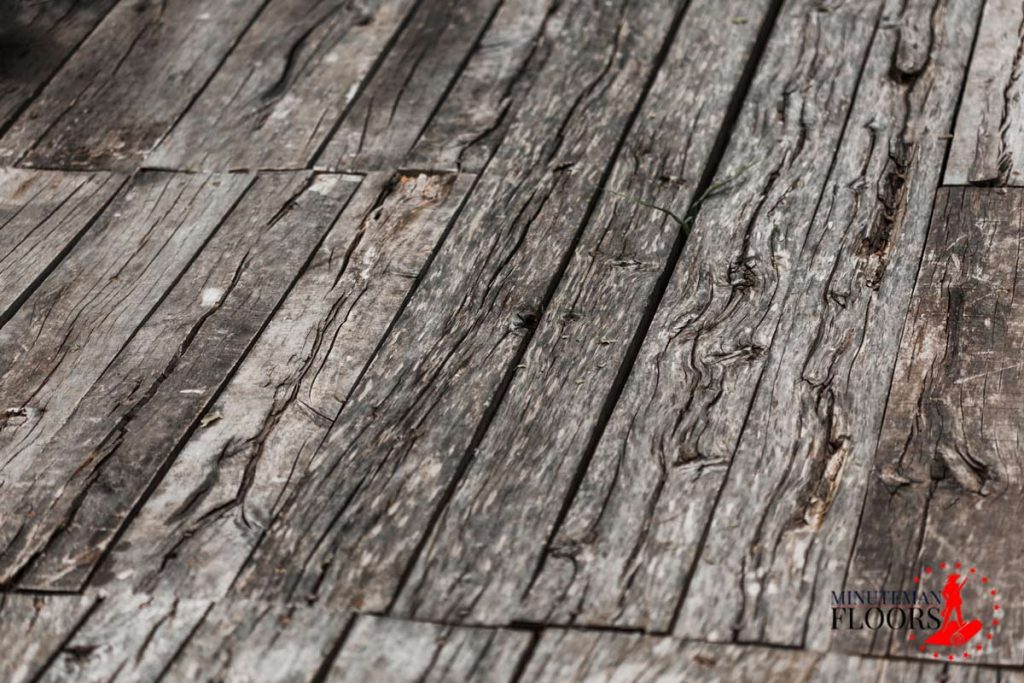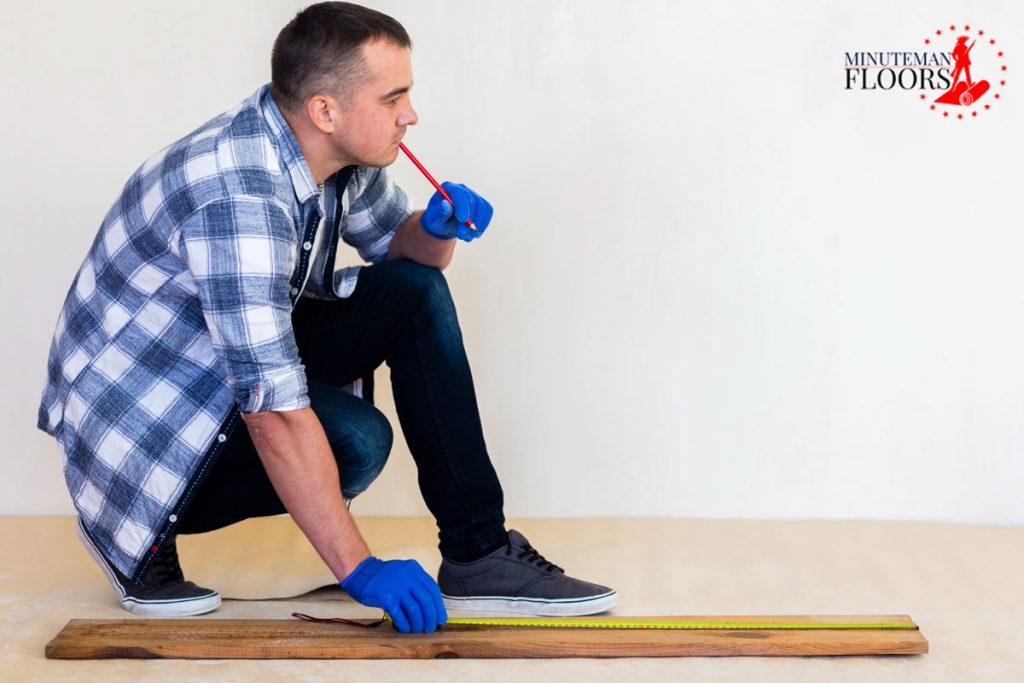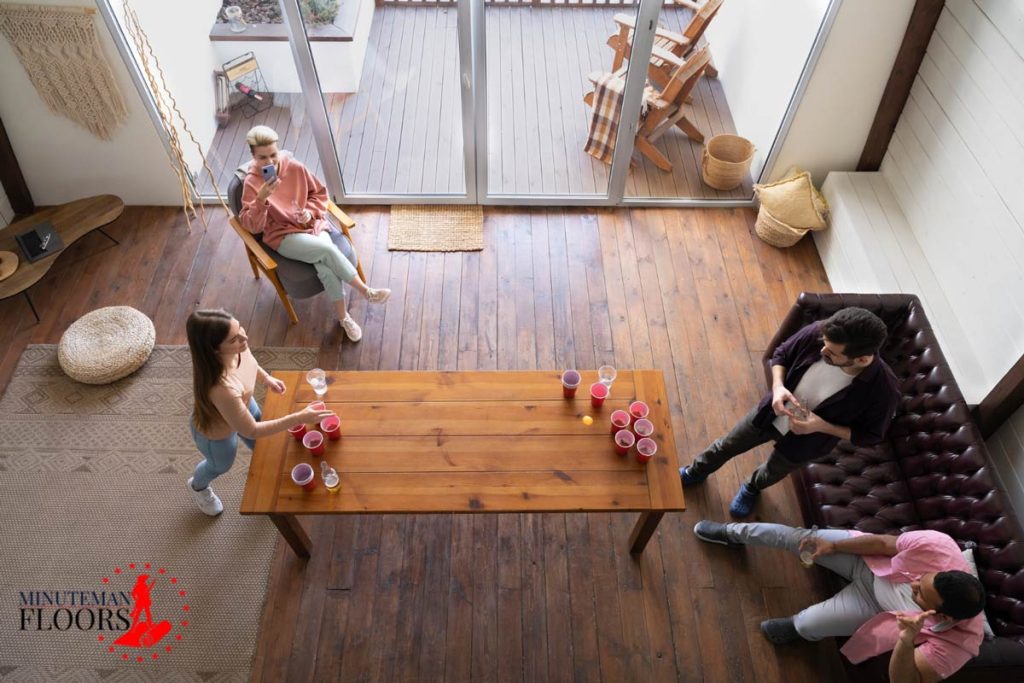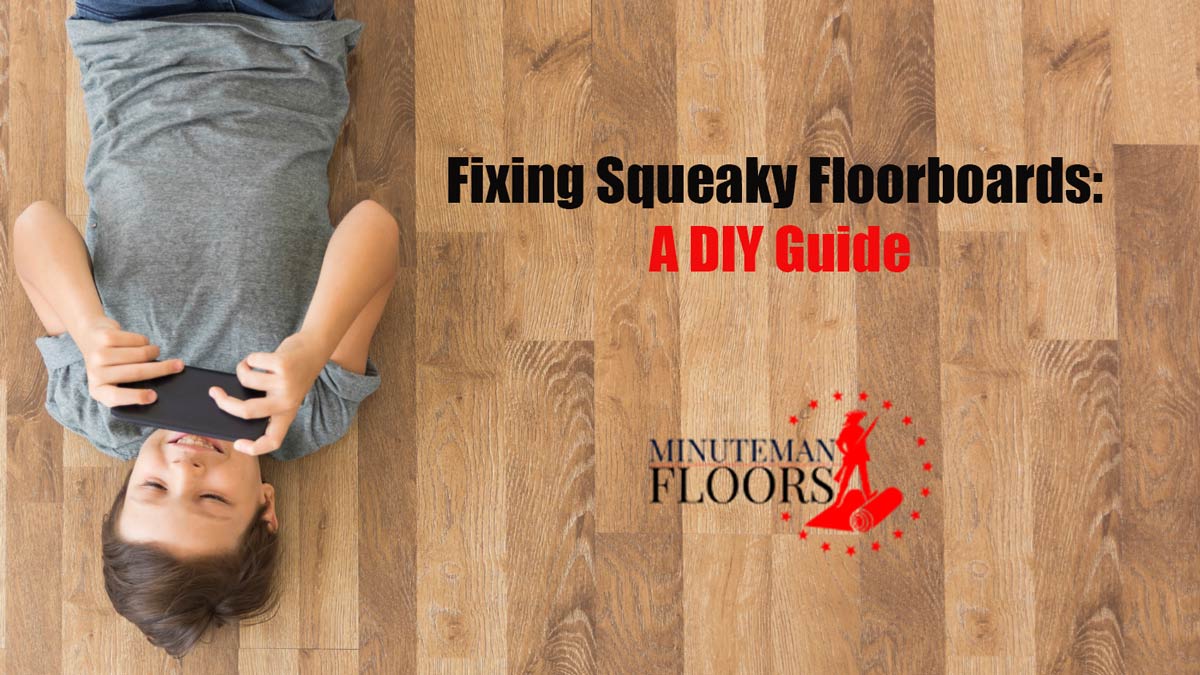Creaks and squeaks are annoying noises we sometimes hear when walking on a wooden floor or stairs. But fixing squeaky floorboards isn’t usually too complicated and can be done without professional help.
In this article, our hardwood flooring installers are guiding you to repair creaky floorboards by yourself with some simple tools and a bit of effort.
So, first, we’ll discuss what causes these creaks and squeaks and a few tips to prevent them from happening in the future. Then, we’ll introduce the DIY solutions for squeaky floors, how to locate and identify the cause, and the tools you’ll need.
Did you know a good professional hardwood installation reduces future issues and damage?
Call Minuteman Floors in Manchester, NH for installation, refinishing, and repair.
Common Causes of Squeaky Floorboards
The creaks we hear when walking across wood panels come from the boards rubbing against each other or against the subfloor, which can have different causes.
- Loose Floorboards
If the boards aren’t installed and fastened properly, they can cause squeaks and creaks. Also, the nails and screws become loose over time and lead to shifting and rubbing of the floorboards against each other or the subfloor.
In either case, you may notice some missing or loose nails and screws, or see gaps between the boards. Another sign of loose floorboards is that the boards may feel spongy under the feet.
- Dried Out Wood

Wood can lose moisture or gain it from the environment. When it gains moisture, it expands, and when it loses it, it contracts. So, dried-out floorboards can shrink and create little gaps between them and the walls or other fixed surfaces, the subfloor, and the surrounding boards.
These gaps allow the floorboards to move when stepped on, resulting in squeaks and creaks.
Therefore, if there have been fluctuations in humidity levels or even temperature, you might see some visible cracks between the noisy floorboards. Also, when wooden boards dry out, they feel inflexible and rigid under the feet.
- Problems with the Subfloor
Subfloor condition plays an important role in how well flooring is installed and how stable it is. So, if, from the beginning, the underlying subfloor isn’t properly prepared for hardwood installation, you can’t expect the floorboards to be secured well.
However, sometimes the subfloor is even and in good condition at the time of installation, but later it gets damaged. For example, it can become warped or the floor joists break.
Many subfloor issues lead to problems with the floorboards as well. And, one of the most common ones is noisy boards.
What’s more, there should be enough lubrication between the floorboards and the subfloor, otherwise, these layers rub against each other and create noise.
So, if you notice any unevenness, sagging, and warping in the subfloor, or you hear squeaks where floor joists are located, your subfloor is most probably causing creaky floorboards.
- Heavy Foot Traffic
Certain areas get more foot traffic, like hallways, stairs, and entryways. This can cause the floorboards to loosen and make noises when stepped on.
All in all, it’s important to know what causes squeaky floorboards to be able to prevent it from happening or to select the right solution to deal with it.
Tips for Preventing Future Squeaks in Floorboards
Follow the guidelines below to reduce the risk of getting noisy floorboards in the future.
- Hire professional installers who can install hardwood flooring properly. An experienced installer knows how to prepare the subfloor, what type and size of nails and screws to use, how much space is needed between floorboards, etc.
- If you notice any loose board, reinforce it by adding additional nails/screws or adhesive.
- Especially in high-traffic areas, consider using floor clips for a better grip.
- Try to maintain the humidity levels (with the help of a humidifier or a dehumidifier) and the temperature. The ideal humidity level is 30% to 50% for hardwood flooring. (Read more about the Relation Between Climate and Flooring here.)
- Consult with a professional to find out if you need to apply any wood conditioner or sealant and how often you should do that.
- Reinforce or replace damaged and weak floor joists.
- Using a subfloor underlayment is recommended to provide a more even base for the flooring and prevent friction between the layers.
- Apply lubricants or gliders between the layers to reduce friction.
- Rugs and runners can reduce wear and tear in high-traffic areas.
- Seal the gaps around the perimeter of the floor.
- Inspect the floor and the subfloor regularly to identify damage and issues and address them before they become more serious.
- Follow the right hardwood flooring maintenance guidelines.
Although having a few squeaky floorboards once in a while isn’t uncommon, following these preventive measures can significantly reduce it and extend the lifespan of a hardwood floor.
Fixing Squeaky Floorboards Yourself
To get the best results from DIY fixing squeaky floorboards, follow the steps below.
Step 1: Inspect the Floor

First, you should diagnose the root cause of these creaks and squeaks because each issue can be resolved in a specific way. Also, if you don’t address the underlying issue first, soon you’re going to hear the irritating noises again.
So, start a thorough inspection of the floor, particularly the noisy areas. Look for the signs below.
- Loose floorboards, nails, screws,
- Moisture and water damage,
- Gaps between the boards, or between the boards and the walls,
- Floorboards rubbing against each other.
Step 2: Inspect the Subfloor and the Joists
If you couldn’t find the cause in the floor, then the subfloor is most probably causing the squeaks. In some buildings, the subfloor is directly accessible through the basement or a crawl space. So, you can examine the condition of the joists and subfloor panels. See if you notice any
- warping,
- excessive moisture,
- floor deflection,
- mold,
- cracks,
- loose panels,
- and any other damage.
If you can’t directly access the subfloor, insert a telescoping mirror between the floorboards and use a flashlight to see what’s going on down there. Can you see any sign of damage?
Also, walk across the noisy areas of the floor or jump up and down a little if needed. Do you feel any unsupported boards under your feet? Is there any excessive give?
Besides, you can use a screwdriver and gently tap the floorboards and subfloor panels. Can you hear any hollow or dull sounds that might be a sign of an issue?
If you still can’t figure out what’s causing the creaky floorboards, it’s better to ask a professional for help. But if you’ve diagnosed the problem, it’s time to decide what’s the best solution and gather the right tools.
Step 3: Choose the Right DIY Solutions for Noisy Floorboards the Necessary Tools
Here are a few solutions and the tools needed to fix squeaky floors.
For Loose Floorboards
After locating the loose boards, try to find the existing screws/nails that are holding down the board. You can use a screwdriver or a nail punch to locate them. Then, if they’re loose, drive them in deeper or use a longer one.
You can also apply wood glue or any suitable construction adhesive to create a stronger bond between the board and the subfloor.
If the board is still not secured, consider installing L-brackets around the edges or floor clips.
For Dried Out Wood
Apply wood floor lubricant to the gaps between the boards to reduce noise and friction. But if the gap is big, a simple lubricant can’t help much. Instead, use a wood floor filler to seal the gaps.
However, if the problem is widespread and there is too much shrinkage, it’s better to hire a professional for refinishing.
For Subfloor and Joists Issues
Replace any weak, damaged, or broken joists to ensure a solid and level base for the floor.
For the subfloor, if there are any loose panels, secure them by driving them in deeper or nailing them down.
Also, make sure that the subfloor is even and undamaged. Fix the damage first, for example, if there’s mold or water damage. Then, you can try shimming the uneven spots.
For Friction Between the Layers
You can reduce the direct contact between the floor and the subfloor by inserting small wood shims or plastic spacers. Also, applying talc powder or silicon-based lubricant between the layers can go a long way.
In addition, check the underlayment and make sure that it doesn’t move because of gaps or improper installation.
For High-Traffic Areas

It’s a good idea to add more nails/screws to the boards in hallways, entryways, stairs, and other high-traffic areas. These extra fasteners can help secure these floorboards better.
If there are any noticeable gaps, gouges, holes, etc., a wood floor repair putty can fill them very easily and quickly.
For Temperature and Humidity Changes
If there have been significant fluctuations in the temperature or humidity levels and now you can see some gaps around the perimeter of the room, you should seal them with caulk or weatherstripping.
Sealing these gaps is necessary to prevent excess moisture from getting into the lower layers.
Overall, fixing squeaky floorboards in most cases is easy and you won’t need very special equipment and tools. However, if you’re not sure what’s causing the squeaks, or the problem is widespread, it’s highly recommended to hire a professional to avoid further damage and costly repair.
Call to talk to our flooring experts and schedule an appointment.
FAQs about DIY Fixing Squeaky Floorboards
Here are some of your common questions when it comes to fixing squeaky floorboards.
Should I Fix Squeaky Floorboards Myself or Hire a Professional?
Whether fixing squeaky floorboards can be done as a DIY project or needs professional help depends on the factors below:
- Is it only a small area or is the problem widespread?
- Can you directly access the subfloor? (If yes, it can be easier for DIY solutions, if not ask a professional for help.)
- Is the root cause a simple problem, like a loose board? Or is it a complicated one, such as a warped subfloor?
- Is it safe to do it on your own?
Consider every aspect of the factors above and see if you think the project is DIY-friendly or not. Particularly, if there’s a risk of harming yourself or causing more damage to the floor, just call a professional.
How Can I Prevent Creaky Floorboards?
Proper installation and maintenance are key. Also, regularly inspect the floor and the subfloor to identify issues quickly before they become a big problem. In addition, try to maintain the same levels of humidity and temperature.
How Can I Reduce the Creaks and Squeaks of the Floor in High-Traffic Areas?
The floorboards in these areas become loose more easily. So, add a few more fasteners or apply wood glue to keep them in place more firmly. Also, use runners and rugs to reduce daily wear and prevent squeaky floorboards. (Learn more about Hardwood Floor Maintenance in High-Traffic Areas here.)
Hire Our Professional Hardwood Installers in Manchester, NH
The process of installing hardwood flooring isn’t easy and quick. As we’ve discussed, even some creaks can get on your nerves and fixing squeaky floorboards can be a challenge, let alone more serious hardwood flooring issues that may happen as a result of improper installation.
Minuteman Floors is a reputable flooring company that has been installing, repairing, and refinishing hardwood floors for years in Manchester and its neighboring towns. We’re proud we have gained the trust and respect of our clients because of our high-quality materials and services.
Besides, we always do our best to make the process easy for you. That’s why, you don’t need to come to us. Just call 603-782-1942 or fill out the contact form and we’ll bring the whole store to you!

